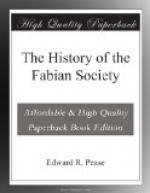The next move was one of a practical character. The Fabian Society had always taken special interest in Local Government, as a method of obtaining piecemeal Socialism, and had long acted as an informal Information Bureau on the law and practice of local government administration. The success of the I.L.P. in getting its members elected to local authorities suggested a conference of such persons, which was held at Easter, 1899, on the days preceding the I.L.P. Annual Conference at Leeds. Sidney Webb was invited to be President, and gave an address on “The Sphere of Municipal Statesmanship”; Will Crooks was Chairman of the Poor Law Section. At this Conference it was resolved to form a Local Government Information Bureau, to be jointly managed by the I.L.P. and the Fabian Society; it was intended for Labour members of local authorities, but anybody could join on payment of the annual subscription of 2s. 6d. For this sum the subscriber obtained the right to have questions answered free of charge, and to receive both “Fabian News” and the official publications of the I.L.P., other than their weekly newspaper. The Bureau also published annual Reports, at first on Bills before Parliament, and latterly abstracts of such Acts passed by Parliament as were of interest to its members. It pursued an uneventful but useful career, managed virtually by the secretaries of the two societies, which divided the funds annually in proportion to the literature supplied. Several Easter Conferences of Elected Persons were held with varying success. Later on the nominal control was handed over to the Joint Committee, next to be described.
The problem of Socialist Unity seemed to be approaching a settlement when the three organisations, in 1900, joined hands with the Trade Unions in the formation of the Labour Representation Committee, later renamed the Labour Party. But in 1901, eighteen months after the Committee was constituted, the S.D.F. withdrew, and thereafter unity became more difficult than ever, since two societies were united for collective political action with the numerically and financially powerful trade unions, whilst the third took up the position of hostile isolation. But between the Fabian Society and the I.L.P. friendly relations became closer than ever. The divergent political policies of the two, the only matter over which they had differed, had been largely settled by change of circumstances. The Fabian Society had rightly held that the plan of building up an effective political party out of individual adherents to any one society was impracticable, and the I.L.P. had in fact adopted another method, the permeation of existing organisations, the Trade Unions. On the other hand the Fabian Society, which at first confined its permeation almost entirely to the Liberal Party, because this was the only existing organisation accessible—we could not work through the Trade Unions, because we were not eligible to join them—was perfectly willing to place its views before the Labour Party, from which it was assured of sympathetic attention. Neither the Fabian Society nor the I.L.P. desired to lose its identity, or to abandon its special methods. But half or two-thirds of the Fabians belonged also to the I.L.P., and nearly all the I.L.P. leaders were or had been members of the Fabian Society.




